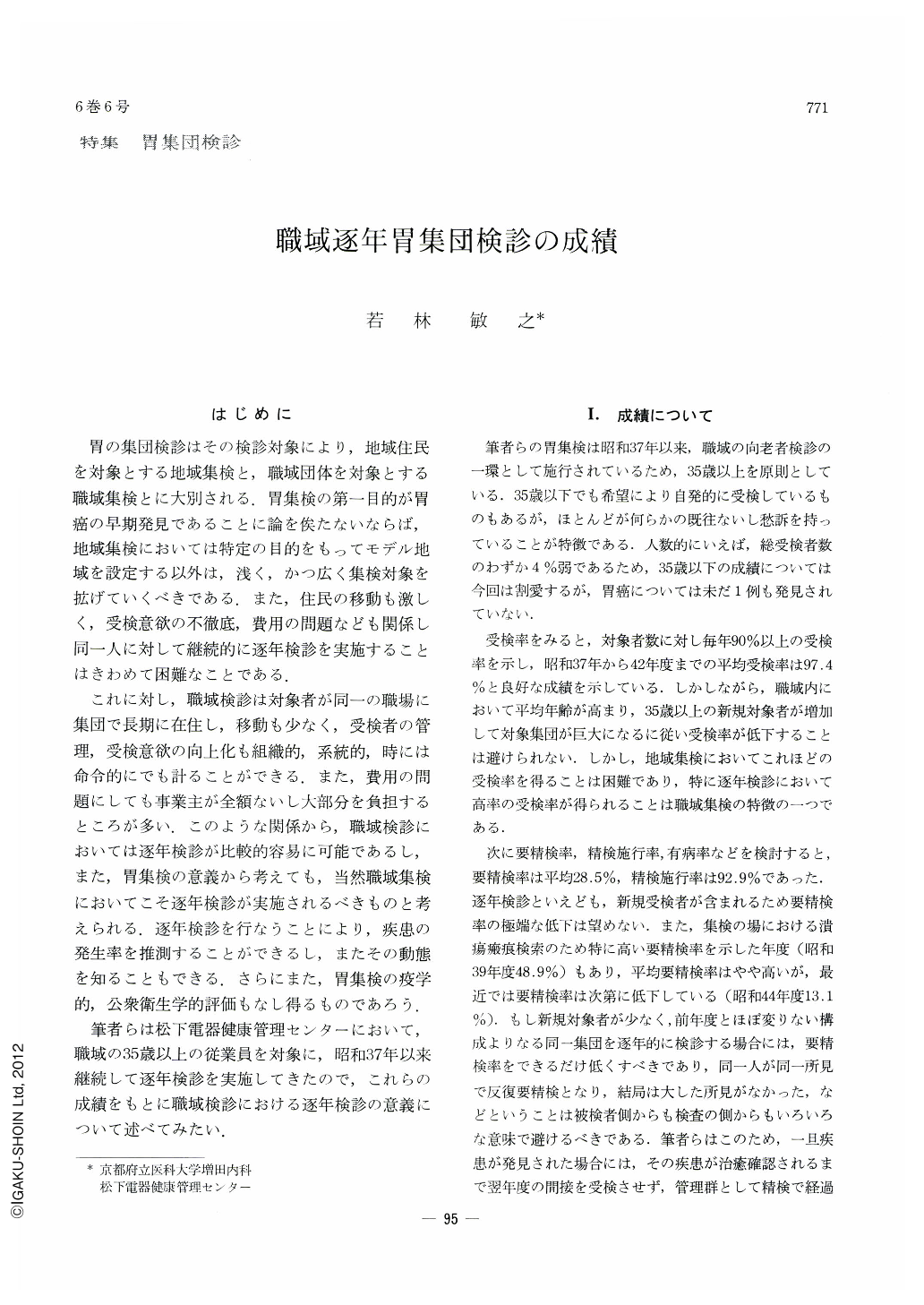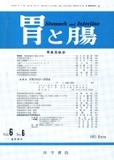Japanese
English
- 有料閲覧
- Abstract 文献概要
- 1ページ目 Look Inside
はじめに
胃の集団検診はその検診対象により,地域住民を対象とする地域集検と,職域団体を対象とする職域集検とに大別される.胃集検の第一目的が胃癌の早期発見であることに論を侯たないならば,地域集検においては特定の目的をもってモデル地域を設定する以外は,浅く,かつ広く集検対象を拡げていくべきである.また,住民の移動も激しく,受検意欲の不徹底,費用の問題なども関係し同一人に対して継続的に逐年検診を実施することはきわめて困難なことである.
これに対し,職域検診は対象者が同一の職場に集団で長期に在住し,移動も少なく,受検者の管理,受検意欲の向上化も組織的,系統的,時には命令的にでも計ることができる.また,費用の問題にしても事業主が全額ないし大部分を負担するところが多い.このような関係から,職域検診においては逐年検診が比較的容易に可能であるし,また,胃集検の意義から考えても,当然職域集検においてこそ逐年検診が実施されるべきものと考えられる.逐年検診を行なうことにより,疾患の発生率を推測することができるし,またその動態を知ることもできる.さらにまた,胃集検の疫学的,公衆衛生学的評価もなし得るものであろう.筆者らは松下電器健康管理センターにおいて,職域の35歳以上の従業員を対象に,昭和37年以来継続して逐年検診を実施してきたので,これらの成績をもとに職域検診における逐年検診の意義について述べてみたい.
Gastric mass survey in one occupational group is easy to conduct on the consecutive yearly basis because not only is systematic control of their health including mass survey of the stomach made with ease as they remain in the same place of work for a long time, but also the cost of examination is usually met by their proprietors. Since 1962 the authors have performed mass gastric survey on the year-to-year basis at the Health Control Center of Matsushita Electric Company on employes over the age of 35. The mean rate of examinations actually undergone by them is 97.4 per cent, and the rate of referred persons for thorough check-up is 28.5 per cent. Of these, 92.9 per cent have actually undergone thorough examinations. Gastric ulcer and its scar has shown a tendency to decrease in number, but incidence of other gastric diseases has not shown much difference. Even succesive yearly mass examinations did not decrease the detection rate of gastric cancer to zero, owing to its overlooking, new crop-ups and fresh employes.
At the first survey, 62,6 per cent of gastric: cancer thus detected belonged to advanced one, but in the succesive yearly examinations early cancer was seen as many as 64.7 per cent. This fact bespeaks eloquently the necessity of yearly mass survey for detecting gastric cancer in its early stage.
Vicissitude of gastric ulcer has also been studied on 806 examinees seen for four years running. The healing rate of gastric ulcer within the same group is 63 per cent, and its recurrence rate, 18.2 per cent. The rate of its occurrence is presumed to be 1.9 per cent. Development and reccurrence of gastric ulcer have decreased in the course of four years.
Of 19 cases of protruding lesions of the stomach found during the four consecutive yearly examinations, it has been seen that 13 could be picked up by re-examination of indirect x-ray films taken in the previous year.
Gastric mass survey on the year-to-year basis is of great significance not only for detection of early gastric cancer but also for finding its protruding lesions as well as for analysis of dynamic transition of gastric ulcer.

Copyright © 1971, Igaku-Shoin Ltd. All rights reserved.


